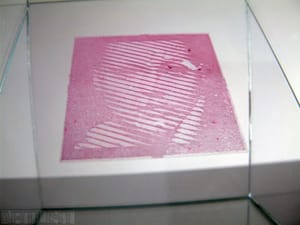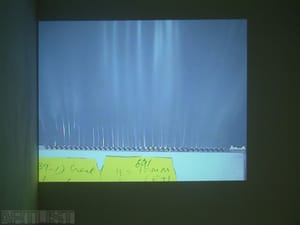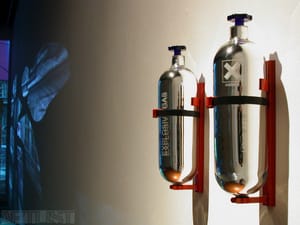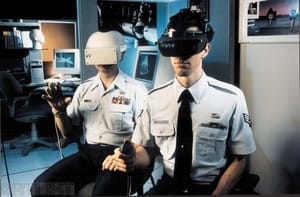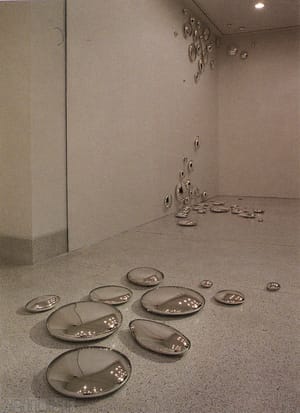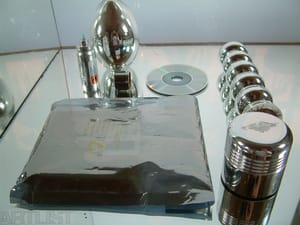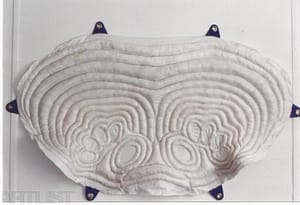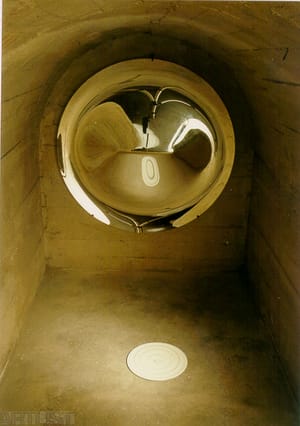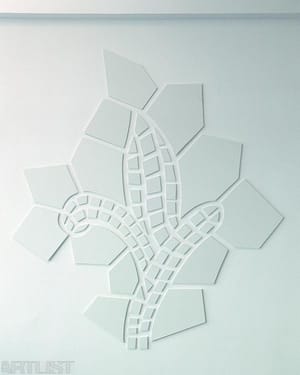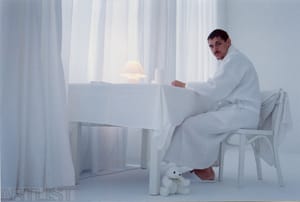- First Name
- Pavel
- Surname
- Kopřiva
- Born
- 1968
- Birth place
- Duchcov
- Place of work
- Prague
- Website
- www.pavelkopriva.name
- i-datum
- ↳ Find in the VVP AVU database
- Keywords
- CSU Library
- ↳ Find in the catalogue
About artist
Pavel Kopřiva creates multi-medial objects and installations, while also working with photography and video art. His work is characterised by a conceptual approach. Kopřiva’s interest lies in various technologies and designs whose methods he shifts into a fine-art context. His objects and installations are derived from experience with a post-industrial and post-totalitarian society. He comments on social phenomena and events that he works into his work with an ironic distance. He is a master of fiction and mystification. The social aspects of Kopřiva’s work were already apparent in his first oeuvre – a land art work from 1992 which he himself claims to be influenced by artists such as Richard Long and Miloš Šejn. But in the background of this interest in nature stands Kopřiva’s experiences arising from his life in the North Bohemian coal areas - a region highly impacted by industrial exploitation. The erosiveness of the land is a source of a feeling of insecurity that permeates the artist's work. This feeling is already evident in the following work – in relativising installations of sorts: Electrical Fiction (1993), Gardening-Cultivating Fiction (1993), Logic as Fiction (1994). The very title of the word “fiction” indicates that it is a mystification of the viewer: “I examine systems and then disrupt and alter them and then serve them back to the viewer, who then examines from his normal perspectives, though something in them doesn't seem right to him. That's an interesting point for me, to share with him that not everything is brilliant. There can be lots of errors, especially when things are created sophisticatedly," says Kopřiva.
In his work Electrical Fiction Kopřiva demonstrated the installation of handmade electrical circuits that were plugged into false outlets. However, the viewer did not know this and the installation caused a threatening feeling. Only the enlightened viewer could know that the electrical circuits “had faults" and could not work. In his UFO project (1995) he again played with this type of mystification: He created a glass object that evoked the image of a flying saucer. Using a mobile crane he photographed this object (characterised by a NASA-like visual representation) and sent the picture to a newspaper. Kopřiva thus created an ironic take on ufology as a pseudo-scientific system.
He returned to extra-terrestrial civilisations later, in 2000 for instance, when he created the object Born 1947, which is a strangely mysterious object, paraphrasing the "extra-terrestrial" object found in a Nevada desert in 1947. A feeling of anxiety and mystification also permeates another project by Kopřiva, May Day (2001). Digital photography places us here in the position of a viewer – a visitor to a technically equipped room in which a kind of secret, mysterious research is taking place. Many of Kopřiva's project work with several media at once. His inter-media works include the Chameleon Skin installation (2004). He screened on a gallery wall made up of mirror fragments a transmitted on-line film recording of activity on the street right beyond the gallery wall, directly connecting the gallery and street space.
Other projects bring the viewer right into play. In the performance project Everybody Needs the Podium (2006), Kopřiva installed in the gallery an exact copy of a briefing room from the Pentagon (which we are familiar with from TV). The gallery’s visitors were invited to go up on the podium and be photographed in a situation that we're familiar with from the media. An interest in modern technology, science and research, whose findings he either directly applies to modern art or paraphrases them, is also characteristic of Kopřiva. A recent work utilising the most recent discoveries is High Voltage Image (2009). He worked on this with the nanofiber laboratories of the Technical University in Liberec. This is a cycle that makes use of a new scientific method for art: “It is a project in which the phenomenon of composing a nano-fiber structure depending on the conductivity of the substrate material and on the high voltage value”, said Kopřiva. The result is subtle abstract “pictures”, in which Kopřiva works with microscopic shots that he modifies and that aestheticise the most recent research attempts.
Fiction, mystification, dysfunction, sarcastic humour, ironic de-masking of social systems… these are words that can be used to characterise the work of Pavel Kopřiva. He likes commenting on and paraphrasing “mysteries”. He enjoys new technologies and questions of aesthetics and beauty. Many objects appear perfect, even "beautiful”. Is it a design or an object with a specific purpose? Hard to say. And that’s the very challenge that Pavel Kopřiva presents to the viewer.
- Author of the annotation
- Ivona Raimanová
CV
Studies:
2000-2004 Academy of Art, Architecture and Design, Prague, (Ph.D. Degree)
1989-1995 Academy of Art, Architecture and Design, Prague (prof.Harcuba.prof.Matasová) M.A. Degree
1987-1989 Art Department, Faculty of Education, Ústí nad Labem
1982-1986 Secondary Jewellery Art School, Jablonec nad Nisou
Work / Employment:
since 2007 head of the Digital Media Studio, Faculty of Art and Design,
UJEP University, Ústí nad Labem
2004-2007 assistant professor, Visual Communication Studio, Technical University, Liberec
1997-2003 assistant professor, Conceptual and Intermedial Work studio, Academy of Architecture, Art and Design, Prague
Stipends:
2006 Ohio Art Council, GallerySpaces, Cleveland,Ohio,USA
1998 Vila Waldberta, Kulturreferat , Mnichov, D
1997 Bildwerk Frauenau, D
1992 Pilchuck Glass school, Seattle, USA
Symposiums:
2009 10. IGS Novy Bor,CZ
2003 8. IGS Novy Bor,CZ
2000 7. IGS Novy Bor,CZ (International Glass Symposium)
1995 Symposium of Flat Glass,Teplice,CZ
Pedagogical knowledge:
2010 The Studio, Corning Museum of Glass
Od 2007 Fakulta umění a designu ,UJEP Ústí nad Labem, Vedoucí ateliéru Interaktivní média ,
2004-2007 TU Liberec,odborný asistent Ateliéru Vizuální komunikace
1999, 2011 Bildwerk Frauenau, D
1997-2003 VŠUP Praha,odborný asistent Ateliéru konceptuální a intermediální tvorby
2001 - finalist of Jindřich Chalupecký Award
Collections:
Galerie U bílého jednorožce Klatovy CZ
ČMVU Praha CZ
Sklářské muzeum, Nový Bor, CZ
Uměleckoprůmyslové muzeum Praha, CZ
Tacoma art museum, Tacoma, USA
GASK , Kutná hora, CZ
Sbírka Cesty skla, Sázava, CZ
Exhibitions
- Solo exhibitions
-
2013
CacheArt, Galerie NF,Ústí nad Labem
Cube x Cube Galerie, Kryštofovo údolí ( s Karolínou Kopřivovou)
2012
Everybody needs the podium II., Galerie Die Actualitet des Schonen, Liberec
2011
Everybody needs the podium II., Galerie Rampa, Ústí nad Labem
2010
Lesní směs ( s Karolínou Kopřivovou) Sklářské muzeum, Nový Bor, CZ
HEAVY DUTY, Galerie Via art, Praha, CZ
Nanoface, FCHT Univerzita Pardubice, CZ
Glas-Kunst-Orte, Neues Rathaus, Weiden, D,
2009
Vše je tak pomalé, Galerie moderního umění, Roudnice nad Labem, CZ
2008
Kosmetika, Galerie Špejchar, Chomutov, CZ
2006
EVERYBODY NEEDS A PODIUM, Gallery Spaces, Cleveland, Ohio,USA
2005
Malé zbraně, Galerie Jelení, Praha, CZ
Spygame, Galerie Sokolská 26, Ostrava, CZ
Spygame, Galerie Raketa, Ústí nad Labem, CZ
2004
Kůže chameleona, Galerie VŠUP, Praha, CZ
2003
POHYBLIVÉ INSTALACE“ performance společně s divadlem Buchty a loutky, studio Švandova divadla Praha, CZ
2002
MAY DAY, Galerie U kostela, Bílina, CZ
2001
MAY DAY, České muzeum výtvarných umění, Praha, CZ
1999
Mělký povrch, Galerie Die Aktualitet des schonen, Liberec, CZ
AREA 51, Galerie V.Špály, Praha, CZ
AREA 51, Galerie ICA-D, Dunauvarosz, H
1998
Mělký povrch, Galerie mladých u dobrého pastýře, Brno, CZ
1997
Vybledlí, Galerie U bílého jednorožce ,Klatovy /s J.Černickým/ ,CZ
Anatomie Mechanismu, Pro Art Mercedes,Praha /s M+M, Mnichov/ CZ, D
1995
Plány nadskutečna, Galerie E.Filly,Ústí nad Labem, CZ
1994
Anatomie, Galerie Suterén ,Ústí nad Labem , CZ
1992
Malá výstavní síň, Liberec CZ
1991
Otevřená hranice bytu,Ústí nad Labem, CZ
- Group exhibitions not included in ARTLIST.
-
2014
Ze středu ven – Umění regionů 1985- 2010, Západočeská galerie Plzeň,CZ
Zóna v pohybu, DOX Praha, CZ
2013
Social design, Galerie E.Filly, Ústí nad Labem
Per Video, Galerie NTK,Praha,CZ
ENTER 6, Galerie NTK,Praha,CZ
2012
Pražský festival skla, Francouzský institut,Praha
Generátor, Galerie E.Filly, Ústí nad Labem
NANOSKOP, Nová scéna ND, Praha
2011
ENTER 5, Galerie NTK,Praha,CZ
2010
POLICE THE POLICE, 4. bienále současného umění,Bukurešť, RO
Rozhraní, Galerie Nod, Praha, CZ
Tvoření světů - Making Worlds, Galerie E. Filly. Ústí nad Labem, CZ
Formate der transormation 89-09, Museum auf Abruf, Vienna, AT
2009
Formáty transformace 89-09, Dům pánů z Kunštátu, Brno,CZ
New Old Cold War, 3.moskevské bienále současného umění, Krasnyj Oktjabr, Moskva, RU
Nanoskop, Galerie Dox, Praha, CZ
Rebus Sic Stantibus, Galerie E.Filly,Ústí nad Labem, CZ
Adapt, festival Enter4, Galerie Dox, Praha, CZ
Křehká krása stříbřeného skla, Novoměstská radnice,Praha, CZ
2008
Aeronále,
Letiště Praha Ruzyně, CZ
Rebus Sic Stantibus, Aboa Vetus,Turku, Fi
Big gruppen Painting“ Hala 23, Praha,CZ
2007
Hot destination,marginal destiny, Motorenhalle, Dresden, D
Transgenesis, AV ČR,Praha
Unsafe distance, ciant, dům U zvonu,Praha
Prostor pro intuici, GHMP Praha CZ
Made in Bor, Sklářské muzeum, Nový Bor, CZ
Křehká krása stříbřeného skla, Muzeum Šumavy, Sušice ,CZ
Zerbrechlische Schonheit des Silberglases, Wallfahrtmuseum, Neukirchen, D
2005
Širší proud, Galerie města Plzně, Plzeň
IV. Nový zlínský salon, Dům umění Zlín, CZ
Insiders, Galerie Futura, Praha, CZ
2004
Observatory, Kunst im Palais, Drážďany D
Hot Destination, Dům umění města Brna, CZ
Insiders, Dům pánů z Kunštátu, Brno
2003
O technice, České muzeum výtvarných umění, Praha
2002
Object, Moravská Galerie, Brno, CZ
ZVON, Bienale of young czech artists, GHMP Praha, CZ
V. Nový zlínský salon, Státní galerie Zlín CZ
2001
Object, ČMVU, Praha, CZ
East of Eden, Czech centre, Munchen, D
Finále ceny Chalupeckého, Národní galerie, Veletržní palác Praha, CZ
2000
Trans Globe, Galerie Mánes, Praha, CZ
Alles in Bewegung, Galerie Barakk, Berlin, D
The End of World, NG Kinský Palác Prague, CZ
on a free theme…but to the point, Galerie V.Špály, Praha, CZ
VIA 2000, Galerie VIART, Praha, CZ public art project
Actual, GHMP Praha, CZ
90th continue, Galerie E. Filly, Ústí nad Labem
East of Eden, Centum kultury Castlle Poznaň, PL
East of Eden, Galerie Wyspa,Gdaňsk , PL
Story, Galerie NoD, Praha
100 + 1, ČMVU, Praha, CZ
1999
Ten chapters of nature, Kunstmuseum,Karlruhe, D
Ten chapters of nature, Art gallery, Rhethimnon, Kreta
Symposium železné plastiky, NG Veletržní palác,Praha
Obyčejné pohádky" gaerie U bílého jednorožce, Klatovy
2. Zlínský salon, Státní galerie Zlín
PUBLIC DISTRICT, Galerie E.Filly Ústí nad Labem
99 CZ, Václavské náměstí, Praha
1998
Tělo a fotografie, Praha - Kolín
Asi,Asi,Asistenti, Výstavní síň VŠUP, Praha
O přírodě, Středočeská galerie, Praha
Black and blue, Galerie Club Otok,Dubrovnik, HR
Ten chapters of nature, Crac Alsace, Altkirch, F
1997
Okresní formát, Galerie E.Filly Ústí nad Labem
Jitro kouzelníků, NG,Veletržní palác, Praha
1.zlínský salon mladých, Státní galerie Zlín
Sever, Galerie V.Špály , Praha
Umění ve veřejném prostoru, NG, Veletržní palác, Praha
1996
Proměna, Galerie Bosny a Hercegoviny, Sarajevo BiH
Interiér vs.Exteriér, areál Cosmos,Bratislava SK
Hi-tech a umění, Dům umění města Brna
Privat anamnesis, Kostel sv.Vojtěcha Ústí nad Labem
MANIFESTA 1,V2 instution, Rotterdam NL
1995
Zkušební provoz, Galerie Mánes, Praha
Orbis Fictus, Valdštejnská jízdárna, Praha
1994
Projekt Istropolitana, Bratislava, SK
Nová jména, Galerie V.Špály, Praha
1993
Krajina v současném umění, Dům U kamenného zvonu, Praha
Narušená rovnováha, Galerie E.Filly
Narušená rovnováha, Galerie Citadela, Praha
Mladí umělci z Prahy, Kunstmuseum , Dusseldorf, D
1991
Bienále uměleckých škol, Barcelona,SP
- Collections
-
Galerie U bílého jednorožce Klatovy CZ
ČMVU Praha CZ
Sklářské Muzeum, Nový Bor, CZ
Uměleckoprůmyslové muzeum Praha, CZ
Monography
- Monography
Pavel Kopřiva, Hand Book. Texty: Michal koleček, Jaroslav Polanecký. Univerzita Jana Evangelisty Purkyně v Usti nad Labem, 2011.
- Articles
www.ceskatelevize.cz/program/port/elektrotechnika/245-nanoportret




